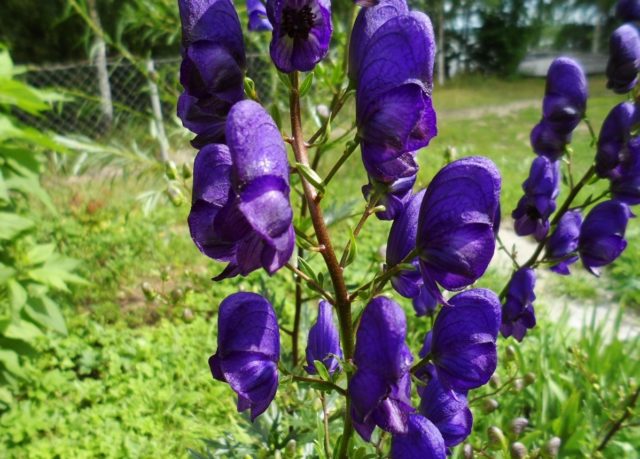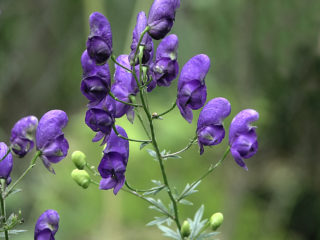Content
Wrestler or aconite (Aconitum napellus) is a species of perennial plant with a wide range: it grows in Europe, Poland, and Germany. In Russia, the main accumulation is observed in the European part. It received its specific name for the resemblance of the flowers to a monastic headdress. The plant is also known as blue aconite.
Description of monkshood
A perennial plant from the Ranunculaceae family, it has a history that dates back to Greek and Scandinavian myths. This focus on culture is driven by toxic chemicals. The roots and the entire above-ground part of aconite contain diterpene alkaloids that are toxic to living organisms. Even a small part of pure aconitine can cause death in humans.
Externally, cap aconite looks quite attractive:
- The height of the herbaceous plant is within 1.5 m. It grows singly or forms several flower stalks, and is visually perceived as a bush.
- The root system is tuberous, superficial, and depending on the age of the plant and the looseness of the soil, it is deepened by 15-30 cm.
- Every year, hooded aconite forms new tubers, the old ones die off at the end of the growing season. The number of stems is directly proportional to the formed roots; on each of them, the shoot produces only 1 peduncle.
- The stems are erect, finely pubescent, dark green, tapering towards the apex.
- The inflorescences are pyramidal, the flowers are located on the stem on short petioles, and begin to form from the middle to the end of the upper part.
- In wild specimens of aconite, they are irregularly shaped, helmet-shaped, and wide. The only pollinator of the species is bumblebees, so the size of the aconite flower can easily accommodate a fairly large insect.
- The leaves are dark green, pinnately dissected, wide, consisting of 5-7 lobes. Located at the base of the bush.

Wild species of aconite are distinguished by blue flowers, hybrids are white, light purple and variegated
Popular varieties
There are more than 250 varieties of aconite, classified by territorial distribution. There are no clear boundaries between them. Some representatives of aconite capulaceae are taken as the basis for hybridization. Specialists created decorative varieties for design and gardening. Cultivars vary in color and height, but otherwise their biological requirements are the same as those of the wild species.
Rubellum
Monkshood Rubellum is a perennial hybrid crop. Grows up to 1 m in height. Forms many flower stalks. The flowers are solitary, up to 10 cm in diameter, located along the stem on short, thick petioles.The flowers are five-petaled, light pink, the upper part is in the shape of a helmet. The filaments are long, chaotically located, beige with a pinkish tint and dark burgundy anthers.

The flowering period of the Rubellum variety lasts from July to August
Bicolor
Aconite hooded Bicolor (Bicolor) is one of the brightest representatives of the culture. Grows in the form of a herbaceous shrub. The stems are branched, leafy to inflorescences, the leaves are deeply dissected, the closer to the crown, the smaller the size. Inflorescence panicles consist of large flowers with double color, the general background is light blue with a blue border along the edge. Blooms from June to August

The Bicolor species blooms abundantly, the stems droop under the weight, so aconite needs a garter
Album
Monkshood Album is a dense, compact, herbaceous shrub. It can grow up to 80 cm in width and up to 120 cm in height. The raceme-like inflorescences consist of large white flowers with a lemon core. The leaves are dense, glossy, deeply dissected, located at the base, dark green. The buds open in June and flowering ends in August.

Aconite Album is widely used in creating white gardens.
Pink Sensation
Aconite Pink Sensation is one of the large-flowered, tall hybrids, grows up to 1.5 m. The stems are erect and thin. Pyramidal panicle inflorescences form at the ends. The color of the flowers is dark pink, several tones darker along the edges. The anthers are brown. There are few leaves, they are located near the ground, dark green, dissected.

The Pink Sensation aconite variety is characterized by long flowering, which begins in the first half of June and ends at the end of August.
Bressingham Spire
Bressingham Spire is a herbaceous plant reaching 1.8 m in height. It forms 2-4 powerful peduncles, the flowers begin to form a paniculate cluster almost at the base of the stem, so the plant looks very decorative. This is one of the darkest colored varieties, the flowers are of the standard shape for aconite aconite, blue with ink-colored veins.

Bressingham's Spire is the latest variety, the buds open in September, the plant blooms until the cold weather
Application in landscape design
Tall herbaceous shrubs are used in almost all design ideas. Cowled Aconite is decorative not only during flowering; thanks to the shape of its leaves, it decorates the area the rest of the time. The culture is used:
- to create a hedge;
- for landscape design in the style of wild nature;
- for the purpose of marking a garden path, when forming impromptu alleys;
- in compositions with flowering and decorative types of flora;
- in floristry for bouquets.
Features of reproduction
Monkshood is a root-tuberous crop; it is propagated by dividing the mother plant in spring or autumn. To rejuvenate the bush, the procedure is recommended every 3 years.
You can propagate monkshood by cuttings. The material is harvested from young shoots before flowering and immediately placed in the ground for rooting. The process is unproductive; of the harvested cuttings, only 15-20% will yield planting material.
Wild species of aconite capulata are suitable for generative propagation, but the process is quite lengthy; the seeds can remain in the soil for a year and germinate only the next season. For hybrids, propagation by seeds is not used, becauseAs a result, you can get plants that are not similar to the mother ones.
Planting and care
Aconite and its cultivated varieties are unpretentious in care and are characterized by good survival in a new place. The plant is perennial, so when choosing a site for planting, the biological needs for lighting and soil moisture are taken into account.
Recommended timing
Cowled borer is a frost-resistant crop, so planting is carried out at the beginning and end of the season. The spring period is suitable for propagation of tubers; activities are carried out approximately at the end of April.
Aconite seedlings obtained from cuttings can be placed on the site at the end of August or left until spring. It is better to divide the bush after the flowering period. Three weeks are enough for the plant to take root; this parameter is used to determine the timing of autumn planting.
Site selection and soil preparation
Basic requirements for the soil: it must be fertile, with good aeration and without stagnant moisture. During the period of autumn rains, aconite may die in an undrained area. An open place is suitable for varieties with light or white flowers. Blue or purple wrestler is placed in partial shade, since the color of the flowers fades in the sun.
The planting area is dug up and weed roots are removed. Humus is added; if the soils are heavy, they are mixed with sand and mineral fertilizers must be added.
Landing algorithm
Planting material is cleaned of soil residues and treated with a growth stimulator.
Planting aconite aconite:
- The hole is dug in accordance with the root system of the seedling; it should be completely covered with soil, but not very deep.
- The bottom is covered with a drainage pad and a layer of nutrient substrate.
- The plant is placed in the center so that the replacement buds are deepened at least 5 cm. If the hole is deep, add soil.
- The root is covered with a nutrient mixture and watered.
It is advisable to cover the root circle with mulch.
Watering and fertilizing schedule
Aconite monkshood responds well to fertilizing. At the beginning of the season, nitrogen-containing products are introduced; this can be done together with liquid organic matter. At the time of budding, they are fed with phosphorus-based preparations. During the flowering period, they are fertilized with potassium and phosphate preparations. Organics can be added in unlimited quantities at any time.
Water the cap aconite as the soil dries out; the plant should not be over-watered. The culture responds better to moisture deficiency than to its excess. The root system is located close to the surface, so there is enough rainfall, especially if the soil around is covered with wood chips or sawdust.
Loosening, mulching
Loosen the tree trunk circle, not going too deep, so as not to damage the root. The procedure is carried out at the first signs of compaction of the upper layer. Aeration is a necessary condition for full development. Mulching will significantly shorten the loosening procedure and maintain optimal soil moisture. Caring for aconite will only consist of removing weeds.
Care during the flowering period
The buds on the inflorescences do not bloom at the same time. At the end of the life cycle, the flowers wither and the plant loses its decorative effect. It is recommended to cut off faded inflorescences, this will be the impetus for the friendly blossoming of buds. The procedure will improve the aesthetic appearance of the bush.
Preparing for winter
The plant is perennial, but the entire above-ground part dies off at the end of the growing season. The main task of the gardener is to preserve the root system from damage.
Preparatory activities:
- All above-ground parts are cut close to the soil surface.
- Carry out water-recharging irrigation.
- Cover the root with peat, straw or dry leaves. If the seedling is of the current year, and winter temperatures in the region are low, you should additionally cover the plant with spruce branches or any covering material.
In the spring, the mulch is removed and hardened off. With a sharp increase in daytime temperature and a decrease in night temperature, the plant will quickly resume its growing season.
Pests and diseases
Aconite can be affected:
- powdery mildew. The drug “Fundazol” is effective against it;
- ring mosaic. They get rid of the problem by removing the affected areas and treating with copper sulfate;
- the most dangerous disease is viral greening, which completely destroys the inflorescences and quickly spreads to nearby growing crops. It is not possible to cure aconite; at the first sign it is removed from the area.
Despite the fact that the crop is toxic, it is parasitized by aphids. They destroy insects with Aktara. A common pest on aconite is the rapeseed flower beetle. Treat the bush with any pesticide.
Conclusion
Monkshood is a poisonous perennial plant with a wide distribution area. The tall crop is represented by hybrid forms with different colors and flowering times. Aconite is used in gardening and landscape design. Decorative varieties are suitable for cutting. The plant is frost-resistant, easily tolerates drought, and is characterized by simple agricultural technology.














